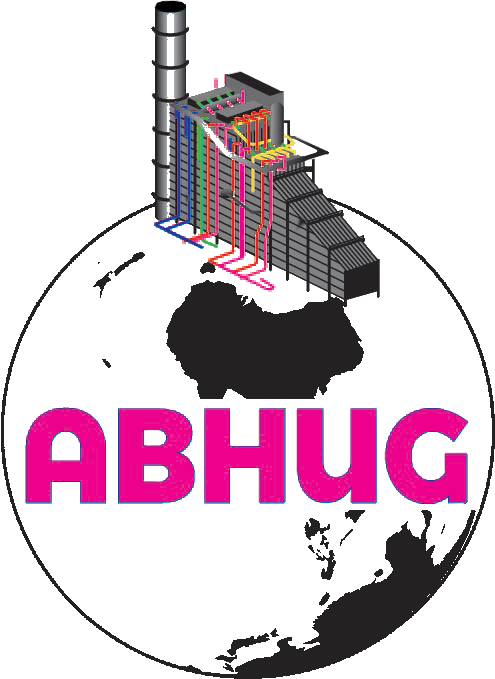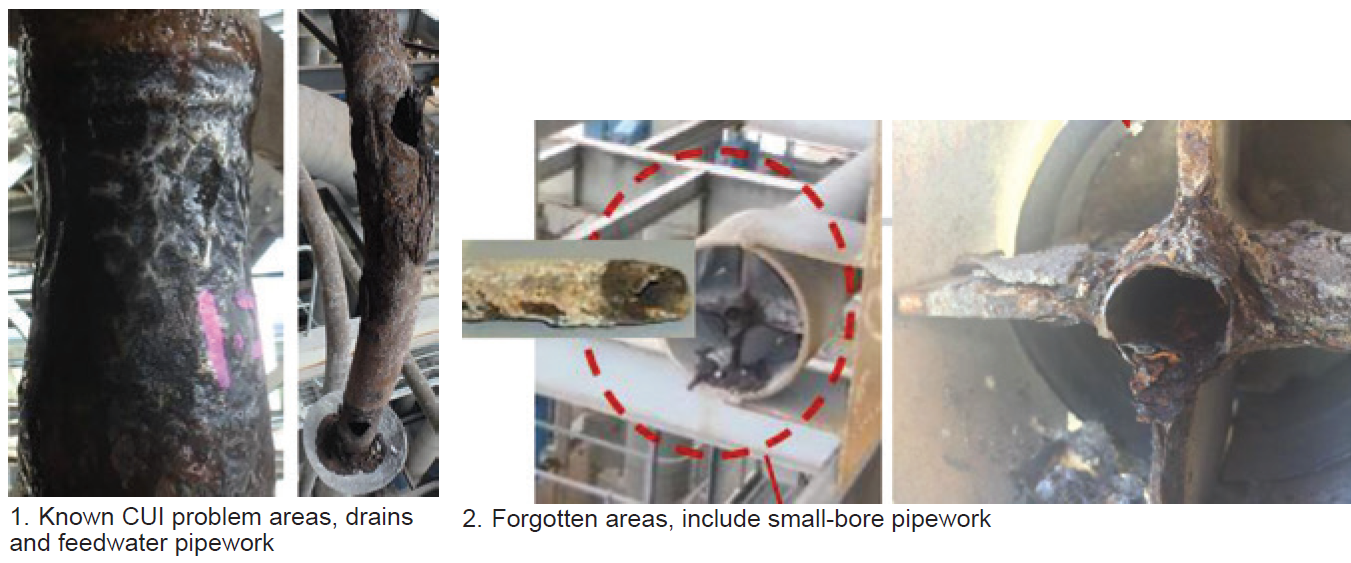 The second workshop conducted at the 2018 meeting of the Australasian Boiler and HRSG Users Group covered the types of corrosion found under insulation (CUI)—galvanic, chloride, acidic, and alkaline-induced—attributed to moisture buildup on the external surfaces of insulated equipment (piping and vessels). If untreated, CUI leads to corrosion and forced or extended outages.
The second workshop conducted at the 2018 meeting of the Australasian Boiler and HRSG Users Group covered the types of corrosion found under insulation (CUI)—galvanic, chloride, acidic, and alkaline-induced—attributed to moisture buildup on the external surfaces of insulated equipment (piping and vessels). If untreated, CUI leads to corrosion and forced or extended outages.
Common temperature ranges for corrosion are covered in API 570, “Piping Inspection Code: In-service Inspection, Rating, Repair, and Alteration of Piping Systems.”
-
- 25F to 250F for carbon-steel pipes, particularly where operating temperatures cause frequent or continuous condensation and re-evaporation of atmospheric moisture.
- Above 250F for carbon-steel piping systems in intermittent service (flexible operation).
A primer. The key influence is water ingress by capillary attraction to the metal substrate. Moisture may be external, or may be inherently present in the insulation material. Resulting corrosion may attack the cladding, the insulation hardware, or the underlying equipment.
For high-temperature horizontal piping, water entering an insulation system diffuses through the insulation towards the hot pipe surface where it evaporates. Insulation adjacent to the hot surface may remain wet (both moisture and salts).
When a unit trips or comes offline for an outage, the pipe metal temperature falls, and the zone of saturated salts solution moves towards the metal OD surface. Upon return to service temperatures, heat will evaporate the moisture in the saturated salts solution, leaving salts on the pipe surface.
If this process is repeated, then the concentration of salts (for example, magnesium or sodium chlorides) will cycle up to a level that initiates corrosion (pitting or stress corrosion cracking).
Therefore, the root cause of CUI is prolonged wetness of steel, occurring with use of water-absorbent insulation. Essential elements are available oxygen, elevated temperature, concentrated dissolved species, and a closed environment.
Where to look. Known problem areas are drains and feedwater pipework. Small-bore pipework was covered as a lesser-known but important area (Figs 1 and 2). Common prevention strategies include these:
1. Painting the pipe surface with boiling-water-resistant coatings.
2. Waterproofing to prevent the ingress of water from outside.
3. Use of corrosion inhibitors.
4. Insulation material selection.
5. Self-draining insulation systems.

Histories and track records of insulating materials were reviewed in detail, traced back to the 1940s when the only available insulation was water-absorbent. The first hydrophobic insulation (expanded perlite) was introduced in the mid-1970s.
But even rigid hydrophobic insulation can allow water to exist behind the insulation. Design flaws can prevent drainage, and sealant applied at the bottom of terminations may trap water. Many examples were presented.
Insulation system design is therefore critical, and self-draining systems are preferred. Thermal conductivities and insulation bulk densities and required amounts were also reviewed and compared. Plus, compressive strengths and differential thermal expansions of surface, insulating materials, and cladding were examined in discussions, illustrating the complexity of the subject.
Fire and other hazards. Insulation system adhesives, vapor barriers, and sealants determine fire performance. These variables must be considered when selecting materials for applications and code compliance. Discussion on this subject covered related issues of combustibility, ignition susceptibility, surface spread of flame, and emissions of smoke and toxic gas. Note that fire performance of non-combustible insulation materials can be changed by the absorption of oil or other flammable liquids that can spontaneously ignite.
Another topic was resistance to molds, health hazards (including adhesives and solvents), removal/replacement risks, and objectionable odors.
Summary: “CUI is difficult to find because of the insulation that masks the problem until it is too late.”
An insulation system should have removable modules to allow maintenance or inspection. A common method of inspection is to cut plugs in the insulation that can be removed to allow ultrasonic testing. However, these plugs can become a pathway for moisture ingress.
Also, if the plug is not in the right location, CUI can be missed. Various detection methods were incorporated into the open discussion, including the following:
-
- Neutron backscatter.
- Thermographic scanning.
- Long-range guided wave.
- Digital and real-time radiography.
- Pulsed eddy current.
- Electrical impedance spectroscopy (emerging).
Finally, case studies were reviewed, followed by fitness-for-service assessment (API, ASME) of corrosion and erosion.
Links to other ABHUG 2018 coverage here:
HRSG experience, issues typically global in nature
Key takeaways from the ABHUG workshop on steam-turbine bypass systems
Endnote: Participants in the 2018 ABHUG conference generally agreed that combined-cycle failure and damage mechanisms sometimes are similar to those experienced in fossil plants and that some joint activities in the future could be beneficial. Boiler tube failures, steam-turbine damage, HEP, and valve issues are areas where collaboration might be productive. In line with this thinking, the steering committee is weighing the benefits of expanding the technical areas covered at the annual meeting and of renaming the event ABHUG (Australasian Boiler and HRSG Users Group) for the next conference.



